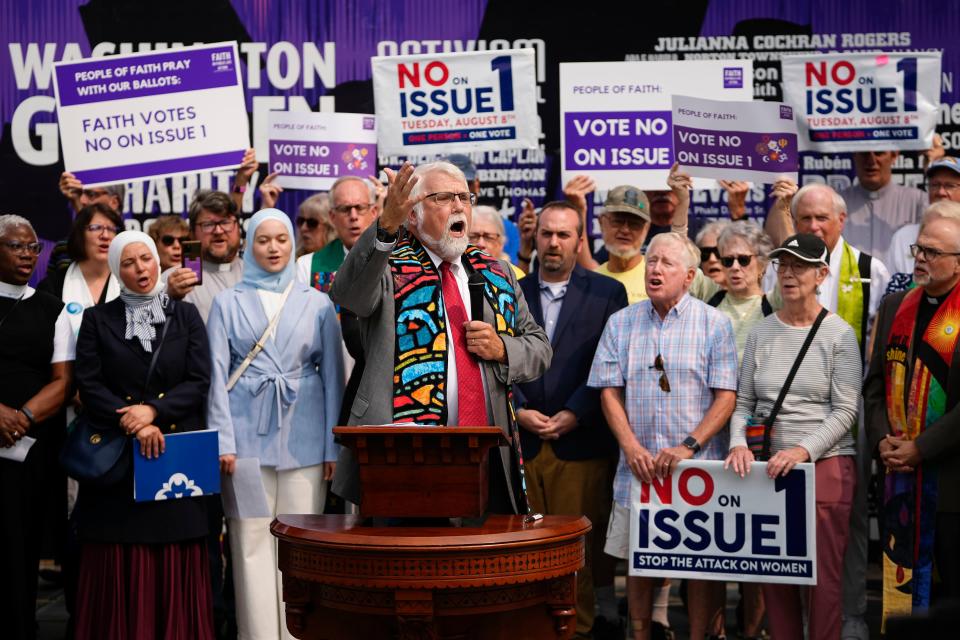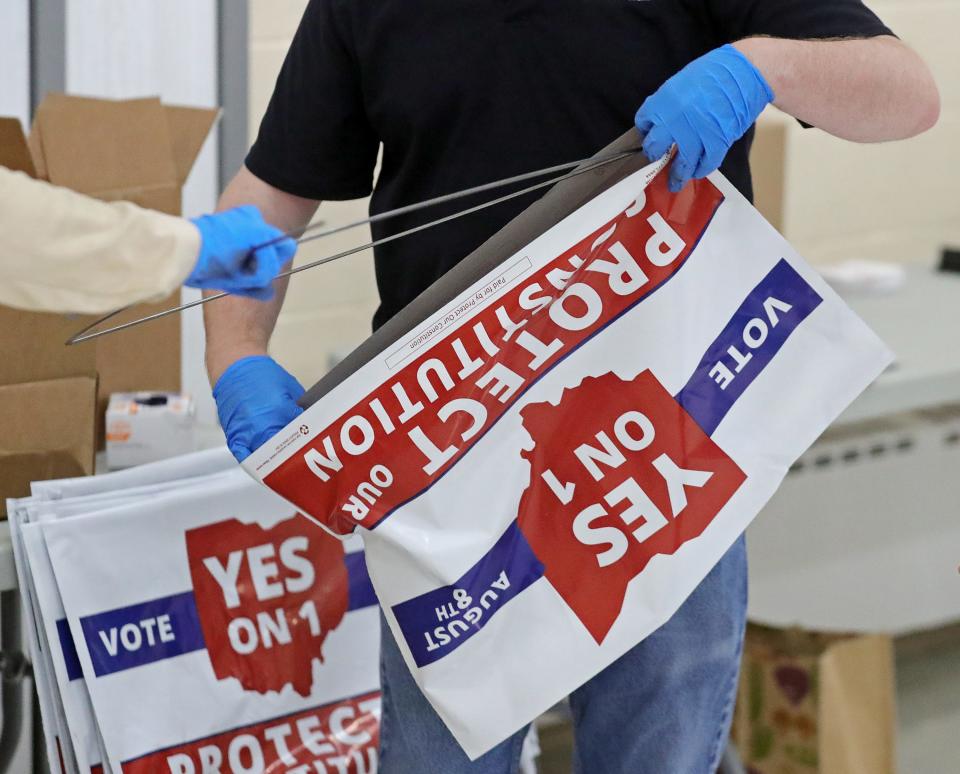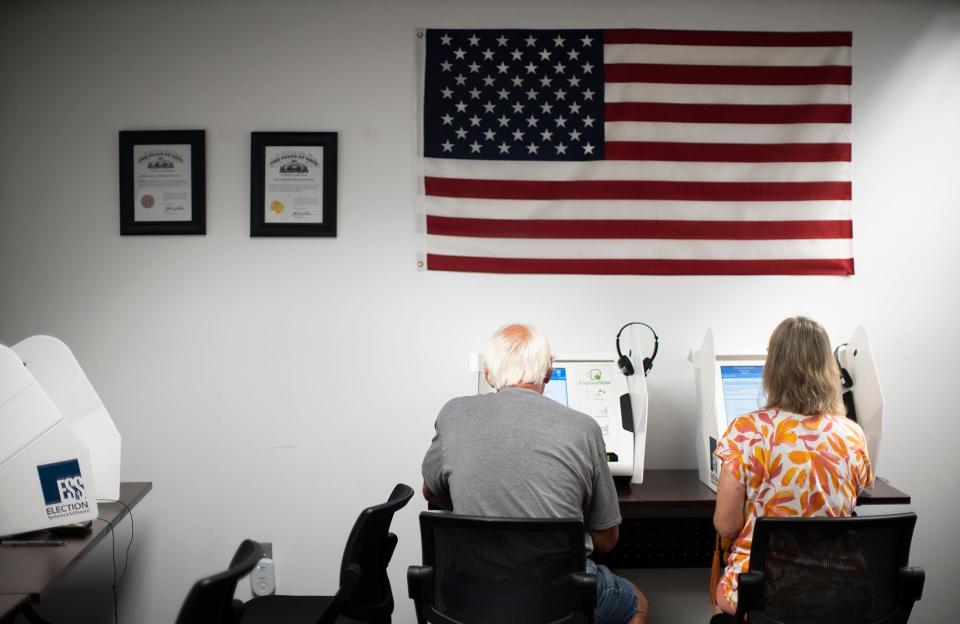Voters reject Issue 1 in Ohio special election, scoring win for abortion rights supporters
COLUMBUS, Ohio — Ohio voters rejected a ballot measure in Tuesday's highly charged special election that would have made it more difficult to change the state's constitution, taking away a simple majority rule.
The controversial proposal was projected to fail, according to Decision Desk HQ, an election results reporting agency providing results and race calls for the USA TODAY Network Ohio. The vote is a blow to Ohio Republicans who wanted to hamstring a November ballot question on abortion rights.
The no vote was leading 59% to 41% with about half of the vote counted, according to unofficial results.
Issue 1 would have raised the threshold to enact new amendments to 60% of the vote, instead of a simple majority of 50% plus one.
Republicans pushed for the election to try and preempt a November ballot question that would enshrine abortion rights in the state's constitution. The higher threshold required would have made it difficult, if not impossible, for the November proposal to succeed, based on polling figures.
Tuesday’s election was the culmination of a months-long fight that began last year, when Secretary of State Frank LaRose and Rep. Brian Stewart, R-Ashville, first introduced a plan to tighten the rules for constitutional amendments. The debate played out in the halls of the Ohio Statehouse, on the campaign trail and even in the courtroom as opponents tried to stop GOP lawmakers in their tracks.
Proponents of the measure said they want to keep controversial policies out of the constitution and reserve it for the state's fundamental rights and values. Critics argued the ballot measure was taking away the rights of citizens.

What would have Issue 1 have done?
In addition to changing the threshold to enact constitutional amendments, it would have:
Required citizens who want to place an amendment on the ballot to collect signatures from at least 5% of voters from the last gubernatorial election in all 88 counties, instead of the current 44.
Eliminated a 10-day cure period that allows citizens to replace any signatures deemed faulty by the secretary of state's office.
Ohioans turned out for special election
Critics of Issue 1 were concerned that turnout would be low, and lawmakers limited August special elections for that very reason. But nearly 642,000 people cast early in-person or absentee ballots, outpacing the early vote turnout for the May 2022 primary.
About 40,000 absentee ballots were still outstanding when polls closed on Tuesday. Mail-in ballots that were postmarked on or before Monday must arrive by Aug. 12 to be counted.
Who funded the Ohio Issue 1 campaigns? Donors from Illinois, D.C. and California
The campaigns for and against Issue 1 relied heavily on donors from California to Washington, D.C. as they blasted the influence of special interests on Ohio politics. The full cost of the election won’t be known until September, when the campaigns face their next filing deadline.
Opponents called Issue 1 a power grab
Opponents gathered at a union hall in Columbus last week to sound the alarm about Issue 1. A packed lineup of speakers, including former Gov. Ted Strickland and former GOP Attorney General Betty Montgomery, accused the issue's backers of trying to take power away from Ohioans.
"When you have focused authority in one branch of government, it is just an invitation for corruption," Montgomery said. She pointed to former Ohio House Speaker Larry Householder, who was sentenced in June to 20 years in prison in the largest corruption scandal in state history.
Canvassers fanned out across Columbus to knock on doors. Unlike earlier in the summer, voters who answered their doors knew all about Issue 1 − and most of them planned to vote no. One of the volunteers, Claudia Cortez, said she's never seen people this angry about an election.
“How much more power do they want?" Cortez said. "Do they want to suck the blood of the working people?"
'Ohio is truly the battleground'
Supporters of Issue 1 were just as energized.
Republicans gathered at a Union County farm on Sunday to hear from party officials and candidates about the importance of Issue 1. Their pitch: Passing this issue is critical to ensuring progressive ideas, such as abortion access and minimum wage increases, don't find their way into the constitution.
"Ohio is truly the battleground," said Mehek Cooke, an attorney who spoke for the anti-abortion group Protect Women Ohio. "They started in Ohio to test us, to test our fundamental values and ideals."

The Union County event featured U.S. Senate candidate Bernie Moreno, U.S. Rep. Jim Jordan, R-Urbana, and Kari Lake, a Republican who lost last year's race for Arizona governor. While Moreno and Jordan mentioned Issue 1, the three also used their remarks to discuss the 2024 election and attack President Joe Biden and U.S. Sen. Sherrod Brown, D-Ohio.
Still, Tuesday's election was the focus among Republicans statewide.
"One of the reasons there's such discord in this country is that we've become all or nothing," state Sen. Matt Dolan, R-Chagrin Falls, said during a stop at the Ohio State Fair. "So if we're going to change the constitution − documents that are designed to support our beliefs, our cultures, our traditions, our people and our rights − if we're going to change that, let's have a complete buy-in."
Dolan is also running in the Republican U.S. Senate primary for the chance to take on Brown in 2024.
Both sides believe their bases are fired up, and they're encouraged by surprisingly robust early voting turnout. But it remains to be seen how that enthusiasm will translate to Election Day − and which campaign was most effective in selling its message to Ohioans.
"I think Issue 1 is going to be super close," U.S. Sen. J.D. Vance, R-Ohio, told reporters at the state fair. "You could have a million and a half, maybe 2 million votes. It's probably going to be decided by a few thousand people. So get out there and make your voices heard. Even if you disagree with me, get out there and make your voice heard."

Contributing: USA TODAY Newsletter Writer Nicole Fallert. Haley BeMiller is a reporter for the USA TODAY Network Ohio Bureau, which serves the Columbus Dispatch, Cincinnati Enquirer, Akron Beacon Journal and 18 other affiliated news organizations across Ohio.
This article originally appeared on The Columbus Dispatch: Ohio special election: Voters reject changes to Ohio Constitution

